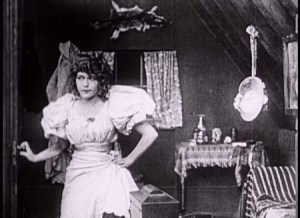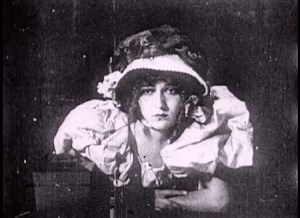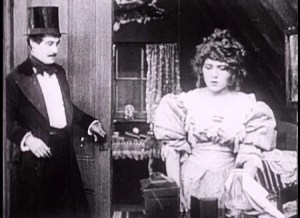 Dora (Mary Pickford) is a “little orphan” with “eager eyes and bright smile.” Despite what the intertitles in the film tell us, she is clearly a prostitute. She indeed makes the Gulch Saloon “an earthly paradise for the rough miners of Golden Creek.” But her heart belongs to Jack, the smooth, “Dandy” gold miner. Friends (Biograph, 1912, directed by D. W. Griffith).
Dora (Mary Pickford) is a “little orphan” with “eager eyes and bright smile.” Despite what the intertitles in the film tell us, she is clearly a prostitute. She indeed makes the Gulch Saloon “an earthly paradise for the rough miners of Golden Creek.” But her heart belongs to Jack, the smooth, “Dandy” gold miner. Friends (Biograph, 1912, directed by D. W. Griffith).
[Other essays on Mary Pickford from this site are: Mary Pickford: “Belligerently I marched . . .”; “Pickford and Griffith: The Clash of Film’s First Great Egos,” ; “Goin’ to California, 1910 and a Mountain of Dreams”; and Mary Pickford’s “Daddy Long-Legs.”]
By 1912, D. W. Griffith had become a master of the short film drama — a form of cinema that allows very little room for digression or superfluous elements. Friends is as good an example of this mastery by Griffith as can be found. Such is his fluency in the medium that it almost takes longer to give a synopsis of the film than it does to view it.
 The surviving film has few intertitles, and there is little evidence that it ever contained more. (Fortunately, there are several excellent 35mm sources for Friends, both negative and positive, at the Library of Congress and George Eastman House, both from the AFI/Pickford Collection, as well as MoMA and The National Film and Television Archive). Those few intertitles tell us all the basic information we need to know of the characters and their relationship to each other prior to our meeting them. The setting, a mining camp, is unimportant — the story could take place anywhere, at any point in time. It is a tale of simple but elemental human emotions governed by a sense of decency and responsibility — the essence of the relationship between, and among, friends.
The surviving film has few intertitles, and there is little evidence that it ever contained more. (Fortunately, there are several excellent 35mm sources for Friends, both negative and positive, at the Library of Congress and George Eastman House, both from the AFI/Pickford Collection, as well as MoMA and The National Film and Television Archive). Those few intertitles tell us all the basic information we need to know of the characters and their relationship to each other prior to our meeting them. The setting, a mining camp, is unimportant — the story could take place anywhere, at any point in time. It is a tale of simple but elemental human emotions governed by a sense of decency and responsibility — the essence of the relationship between, and among, friends.
 “Dora, the little orphan whose eager eyes and bright smile make Placer Gulch Haven an earthly paradise for the rough miners of Golden Creek. Mary Pickford.” (from the 1st intertitle)
“Dora, the little orphan whose eager eyes and bright smile make Placer Gulch Haven an earthly paradise for the rough miners of Golden Creek. Mary Pickford.” (from the 1st intertitle)
By eliminating the superfluous and minimizing all but the most important elements of the story, Griffith allows his actors time to develop the emotions necessary to move the story forward — and emotions more so than physical action or complex editing schemes are what drives the story.
Dora loves “Dandy” Jack, a gold miner who dresses like a Park Avenue “swell.” Top hat and tux are his sartorial preferences, even on horseback. Dora, in spite of her intertitle description as “the little orphan” with “eager eyes and bright smile,” is plainly a prostitute. She indeed makes the Gulch “an earthly paradise for the rough miners of Golden Creek.” But her heart belongs to Jack — until he leaves her and the Gulch for better mining prospects elsewhere.


Here comes her man . . . “Dandy Jack, A gambolier bond, fine feathers ‘n everything. Henry B. Walthall.” (intertitle, in quotes).


And there she goes again . . . a quick check in the mirror, then downstairs to the bar . . .

 . . . where Dandy Jack seems to pay her no mind.
. . . where Dandy Jack seems to pay her no mind.


Back in her room, Dora finds another way to get his attention . . . and that of the whole bar.


Jack can’t ignore her this time. But he has bad news.

 “Golden Creek’s almost played out, Dora, so I’m going after the big money up north.”
“Golden Creek’s almost played out, Dora, so I’m going after the big money up north.”
After their tearful (hers not his) parting, Jack encounters an old friend, Bill Fallon (Lionel Barrymore). Bill is on his way back to the Gulch and stops by the Saloon where he meets the lovely and now somewhat lonely and definitely available Dora. Dora resists his surprisingly tentative overtures (after all, his nickname is “Grizzly”), but she soon gives in and apparently falls for him: she accepts his proposal of marriage.
Jack returns to the Gulch — the intertitles emphasize that it is “LATER,” — and stops by the Saloon, where the usual crowd of miners and drunks tell him that another man has stolen the heart of lovely Dora. Jack, who doesn’t know the identity of her lucky new man, bets the crowd he can win her back. He marches up to her room, entering with barely a knock. The scene is awkward — for Dora. Jack, acting as if she is his property, closes the door behind him, takes off his hat and begins to make himself comfortable.
Dora moves to open the door, making a half-hearted gesture pointing the way out to Jack. She collapses into tears and into his arms, kissing him repeatedly. Jack sees a picture of a man on her table, picks it up, and recognizes the man in the photo as his pal Bill.
Realizing that he had given up Dora, and that in the interim his friend had honestly won her heart, Jack relents. He gently pushes her away, walks downstairs to the bar and saves face by informing the crowd that Dora had slammed the door in his face and that he has lost the wager. He pays off the bet and as he is about to depart, in walks Bill. The entire saloon gasps as one. But Jack greets Bill, gives a hearty handshake and congratulates him on his engagement to Dora. Bill, of course, has no idea of their prior relationship or what has just transpired in the Saloon. They remain, all three, friends — but it can be safely assumed, never quite the same.


“He is the man I was engaged to marry before you came back.”


“I reckon she’ll marry you, Fallon, but we’ll still be friends.”


Up in her room, Dora reflects on her choice, looking at the picture . . . of Bill. Not all feelings are resolved with a handshake.


No words, but a nearly audible sigh . . .
[Much has been made of this close-up of Mary Pickford at the close of the film — it also is used at the opening in this particular print. Rather than debate its historical significance — close-ups were not unknown in 1912, but not yet a staple of cinematic vocabulary — I prefer to speak of its significance within the film’s narrative. Unlike close-ups of objects (such as the photo of Bill which I have chosen not to show here, and which Griffith used twice in the film), this close-up of Dora serves to emphasize her emotional state which, at the end of the film, seems to indicate genuine doubt about her choices in the film. The frame on the right, above, is the very last in Friends.]
In Friends, Griffith pairs Walthall and Pickford, his two most talented actors, giving them ample screen time within the obvious limits of the single-reel film, to play subtly and very effectively a complex relationship — one with multiple layers — without dialog expressed through intertitles, without easy resort to coarse gestures or crude pantomime. In this film, as much as any Griffith Biograph, we can see the actors being allowed to use what Florence Lawrence referred to as “slow acting.”
Lawrence, the “Biograph Girl,” described the complaints of Griffith’s actors during her tenure (1908-09) at Biograph that they were not being allowed to fully use their skills to more subtly or more slowly develop the action between characters. Instead, according to Lawrence, the actors were subjected to constant harangue by Griffith during filming to work faster and faster in order to satisfy what Griffith told them were the exhibitors’ and the public’s desire for more and more action for their money. He sarcastically compared “slow” acting to “song slides,” and that Biograph’s customers would not pay extra for static film footage, film without action.
But the years after Lawrence’s departure from Biograph brought a sea change in film production, distribution and exhibition. “Features” was the word on everyone’s lips. Longer films, at least two and typically three to four reels or more in length were being imported from Europe, Italy in particular, by American distributors like George Kleine of Chicago, the man who brought the first wave of Italian historical “epics” to the American screen. Although these imports attracted enthusiastic audiences, and were generally lauded by critics (and film criticism was itself in its infancy), the attempts by American producers to make their own “features” were frequently slagged off by critics and the exhibitors who charged that filmmakers were merely padding the slim plots of their movies with extra reels of unnecessary scenes — footage for its own sake — simply to tout them as “epic” productions. But for actors, longer films meant more screen time to develop characters, motivation and more complex interaction.
The Biograph Company didn’t immediately make that leap to “features,” and Griffith made little more than a handful of films longer than a single reel prior to his departure from Biograph in 1913. But he clearly saw that the future of film drama (and he was hardly alone in this) was in the feature-length format, and for several years he had been allowing his actors to stretch out and develop their characters and more subtle interplay between the actors. The two scenes shown above that I have highlighted from Friends stand out as excellent examples of this.
Friends was one of the few Biograph films for which Griffith claimed “author” credit, and along with it the extra pay that he would receive as the scenario writer. He undoubtedly “wrote” far more than were ever recorded — he officially received credit in Biograph records as the author of only a fraction of the hundreds of films he personally directed. Therefore, I think it is reasonable to speculate that this film may have had a closer personal connection for him than most of his work at Biograph.
Friends was completed in July of 1912, one of twenty-four films Mary Pickford made for Biograph in 1912, after returning from a disappointing, even demoralizing stint with Carl Laemmle’s I. M. P. Company, an experience that made her appreciate the wide gulf that separated the product of Griffith and Biograph from the rest of the pack in America at the time. She also realized that remaining with Biograph would be safe, but ultimately pointless in the development of her career — Biograph still did not credit their actors (or their director or cinematographer) by name. Griffith would leave in 1913 for the opportunity to make feature-length films with his own production company. Pickford went out on a high note, making The New York Hat, among the best of her work to that point, and leaving Biograph soon after its release in December, 1912.
In January, 1913, Pickford returned to the stage, on Broadway, in the David Belasco production, A Good Little Devil, for which she received excellent notices in the theater press. But movies were now her passion — it was as if she returned to the stage only to prove to herself that she could still do it. Once her committment to Belasco was completed, she signed a contract with Adolph Zukor and the Famous Players Company. She was no longer a “Biograph girl,” or “little Mary,” but Mary Pickford, the highest paid, most famous star in motion pictures. But her work with Biograph, in my opinion, is of even greater importance. She recognized that acting for the camera was a new art form. And in her films for Biograph with Griffith, Mary Pickford built the foundation for motion picture acting.
* * *
Suggested Further Reading
Biographical works:
Mary Pickford, “Sunshine and Shadow,” Doubleday, 1954; Her highly underrated autobiography, a must-read for everyone from the casual fan to scholar. Particularly vivid account of her childhhood and early years on stage and the Biograph period. Those looking for more information on her “superstar” years and later life, as well as the difficulties of her marriages and the scandals involving Olive Thomas or siblings Jack and Lottie, will find Eileen Whitfield’s biography (below) more suited to their needs.
Whitfield, Eileen, “Pickford: The Woman Who Made Hollywood,” University Press of Kentucky, 2007, paperback;
Brownlow, Kevin, “Mary Pickford Rediscovered: Rare Pictures of a Hollywood Legend,” Abrams, New York and The Academy of Motion Picture Art and Sciences, 1999. Hundreds of rarely seen photographs and essays on individual films by legendary film historian and archivist Kevin Brownlow.
Niver, Kemp R., “Mary Pickford, Comedienne,” Locare Group, Los Angeles, 1969. Difficult, but not impossible to find (if your library doesn’t have it, search bookfinder.com to locate a copy for purchase); Library of Congress archivist and historian Kemp Niver assembled this rare volume, one of the first retrospectives in print of the early work of Mary Pickford, and possibly the first to cover her years at Biograph. It contains many essays and illustrations from Pickford Biographs, including reproductions of the original pages from The Biograph Bulletin (the Biograph Company’s original press releases) with publicity text and stills.
Analytical works:
Usai, Paolo Cherchi, General Editor, “The Griffith Project, Volume 6, Films Produced in 1912,” BFI Publishing, London, 2002; Scholarly essays and film credits on every film made by D.W. Griffith at Biograph in 1912, among them the Pickford films “Friends,” “Female of the Species” and “The New York Hat,” and more.
Recommended viewing:
“D. W. Griffith, Director (Volumes 3 through 6)”, Grapevine Video, www.grapevinevideo.com, covers select films of Griffith at Biograph, 1908 to 1910. Quality varies with the source material, but it is the only way for the average person to see a significant selection of Pickford Biographs. In addition to many other Biograph shorts, these four discs include Pickford shorts from “Her First Biscuits” (April, 1909) through “Willful Peggy” (August, 1910).
See also: the “Bibliography Page,” under the header image for book and publishing details and additional suggested reading on D. W. Griffith, silent film, silent film acting and Pickford’s colleagues at Biograph, including Florence Lawrence and Linda Arvidson Griffith.







I’ve seen only a handful of Pickford’s Biographs but she seems much more “womanly” than in her later big star vehicles. FRIENDS is a good example of this.
Good point. Pickford never considered herself a strong dramatic actress — which I think was not true — and once she became a “superstar” she was less willing to take chances, fearing the public would not accept her in serious dramatic roles, which as the Biographs prove, was also not true. She stayed primarily with comedy and “light” drama. But she was hardly the only actor to “typecast” herself. Take the Gishes and the Talmadges, for example: two sisters each, one was “comedy” one was “drama” without a lot of variation. Norma Talmadge was considered a great “tragedienne” of film, Constance, the madcap. Lillian Gish called herself “funny as a barrel of dead babies,” and sister Dorothy was almost always the comic cut-up. So Pickford’s stereotyping of herself was hardly out of the norm. I think, however, that she had the ability to do all of it as well or better than any of her contemporaries.
Hi nice reading your poost